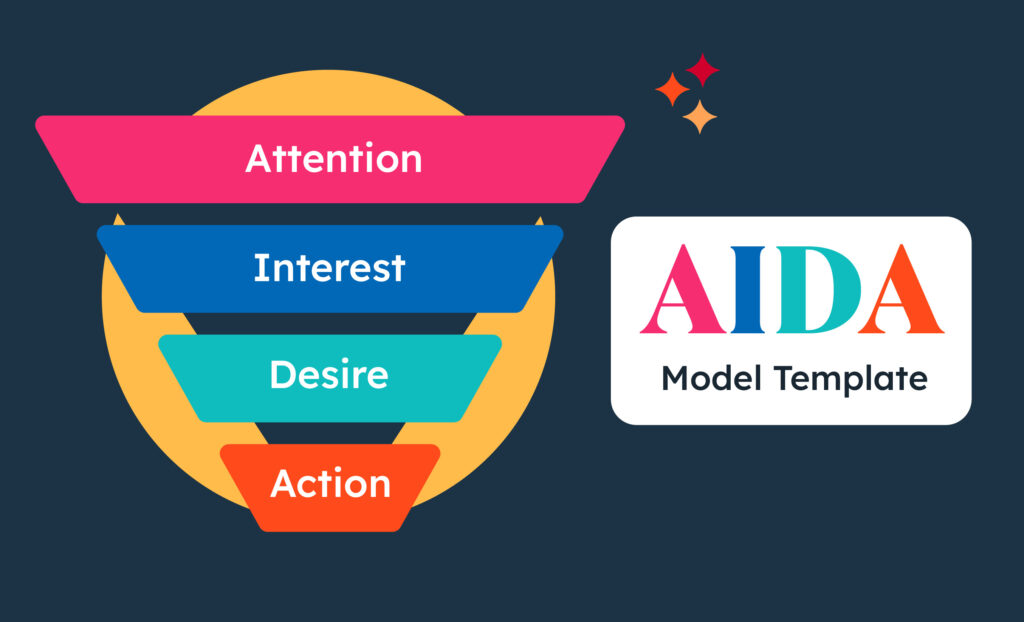In the ever-evolving landscape of marketing and advertising, mastering the art of persuasion and engagement is essential for capturing the attention of your audience and inspiring action. Enter the the Power of the AIDA Model, a timeless framework that serves as a blueprint for crafting compelling copy that drives conversions and fosters brand loyalty. In this comprehensive blog post, we delve into the essence of the the Power of the AIDA Model, exploring its principles, applications, and profound impact on the world of copywriting.

Understanding the AIDA Model:
The AIDA model, an acronym for Attention, Interest, Desire, and Action, outlines a sequential framework for guiding consumers through the stages of the purchasing journey. Developed in the late 19th century by advertising pioneer Elias St. Elmo Lewis, the AIDA model remains a foundational principle in marketing communication, offering a structured approach to captivate audiences and compel them to take desired actions.
1. Attention:
The first stage of the AIDA model is capturing the audience’s attention. In today’s fast-paced digital landscape, attention is a scarce commodity, making it imperative for copywriters to employ attention-grabbing headlines, visuals, and opening statements that pique curiosity and compel the audience to engage further.
2. Interest:
Once attention is captured, the next step is to cultivate interest in the product or service being promoted. Copywriters achieve this by highlighting unique selling points, benefits, and value propositions that resonate with the audience’s needs, aspirations, and pain points. Compelling storytelling, testimonials, and case studies can also be effective tools for building interest and credibility.
3. Desire:
The desire stage aims to stoke the audience’s desire and emotional connection to the product or service. Copywriters leverage persuasive language, emotional triggers, and aspirational imagery to evoke desire and create a sense of urgency or FOMO (fear of missing out). By tapping into the audience’s desires and aspirations, copywriters motivate them to envision the transformative impact of the product or service in their lives.
4. Action:
The final stage of the AIDA model is prompting the audience to take action. This can include making a purchase, signing up for a newsletter, downloading a resource, or engaging with the brand on social media. Clear and compelling calls-to-action (CTAs) are essential in this stage, guiding the audience towards the desired outcome and facilitating conversion opportunities.

Applying the AIDA Model in Copywriting:
To effectively leverage the AIDA model in copywriting, consider the following strategies and best practices:
1. Know Your Audience:
Understanding your target audience’s demographics, preferences, and pain points is paramount for crafting tailored messaging that resonates with their needs and interests. Conduct audience research, gather insights, and create buyer personas to inform your copywriting strategy.
2. Craft Compelling Headlines and Openers:
The headline and opening statement are critical components for capturing attention and enticing the audience to engage further. Use captivating headlines, intriguing questions, or compelling statistics to hook the reader from the outset and encourage them to delve deeper into the content.
3. Highlight Benefits and Solutions:
Focus on highlighting the benefits and solutions offered by your product or service rather than just features. Clearly articulate how your offering addresses the audience’s pain points, fulfills their needs, and enhances their lives. Use persuasive language and vivid imagery to paint a compelling picture of the desired outcomes.
4. Create Emotional Connections:
Emotions play a significant role in driving consumer behavior. Tap into the audience’s emotions by evoking feelings of joy, excitement, curiosity, or even a sense of urgency. Use storytelling, testimonials, and relatable narratives to establish emotional connections and foster empathy with the audience.
5. Build Credibility and Trust:
Credibility and trust are essential for persuading consumers to take action. Provide social proof through customer testimonials, reviews, endorsements, and industry accolades to build trust and credibility with your audience. Transparency, authenticity, and consistency in messaging also contribute to establishing trustworthiness.
6. Create Clear and Compelling Calls-to-Action (CTAs):
The call-to-action (CTA) serves as the linchpin for converting interest and desire into action. Make your CTAs clear, concise, and action-oriented, using compelling language that prompts immediate response. Use contrasting colors, prominent placement, and urgency-inducing phrases to draw attention to your CTAs and encourage click-throughs.

Conclusion:
In conclusion, the the Power of the AIDA Model serves as a guiding framework for crafting persuasive and effective copy that resonates with audiences, drives engagement, and prompts action. By understanding the stages of attention, interest, desire, and action, copywriters can create compelling narratives that captivate audiences, address their needs, and inspire them to take the desired course of action. Embrace the principles of the the Power of the AIDA Model in your copywriting endeavors, and watch as your messaging resonates with your audience, fosters meaningful connections, and drives tangible results in the ever-evolving landscape of marketing communication.


